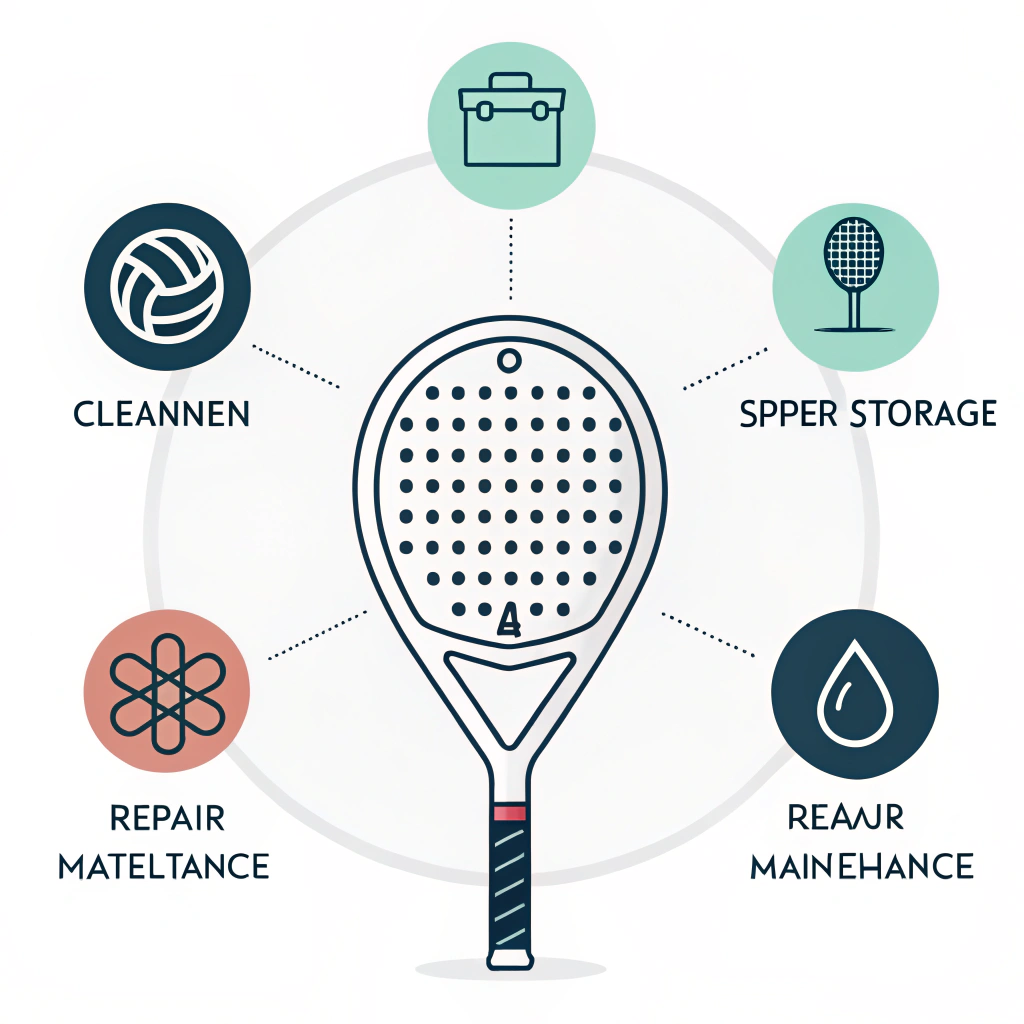Maintaining and extending the lifespan of your padel racket is essential for ensuring optimal performance and reducing long-term costs. By implementing effective maintenance methods—such as regular cleaning, proper storage, and timely repairs—you can significantly increase the durability of high-quality rackets, even those built with advanced carbon fiber technology1 and fiberglass materials2.
The intense pace of padel requires equipment that not only performs well on the court but also stands the test of time. Many procurement managers and sports equipment retailers ask: How can we ensure that our padel rackets maintain their performance and avoid frequent replacements? The answer lies in a series of practical, industry-tested maintenance techniques designed to keep your rackets in top shape, reduce overall replacement costs, and preserve brand reputation.
Padel rackets are subject to various forms of wear and tear during regular play. Over time, impacts, abrasions, and environmental factors like high temperatures or humidity degrade the racket’s materials. This degradation often leads to diminished performance, reduced control, and eventually necessitates costly replacements. A lack of systematic care routines may result in:
- Surface damage: Cracks or scratches on the surface can compromise the racket structure.
-
- Material fatigue4: Both carbon fiber and fiberglass components can suffer fatigue if not properly maintained.
- Environmental harm: Exposure to extreme temperatures or moisture accelerates degradation.
These issues not only affect playability but also reflect poorly on the overall cost efficiency for clubs and retailers who need to maintain an optimal inventory of high-performance equipment.
Several factors contribute to the early aging of padel rackets. Understanding and addressing these factors is the first step toward a sustainable maintenance strategy:
-
Playing Frequency and Style:
Players who engage in frequent, intense matches naturally subject the racket to more stress. Aggressive playing styles can exacerbate the damage, particularly in the frame and surface areas. -
Improper Storage:
Storing rackets in non-ideal conditions such as high humidity, direct sunlight, or extreme temperature variations can induce warping or weakening of the materials. -
Lack of Regular Cleaning:
Dirt, sweat, and debris can accumulate on the racket, harming not only its aesthetic appeal but also its structural integrity over time. -
Neglected Overgrip Replacement:
Overgrips protect the handle from deterioration. Failing to replace worn grips reduces not only comfort but also safety and control during play. -
Inadequate Repair Practices:
Minor damages should be addressed immediately. Neglecting small cracks or abrasions can result in larger issues that necessitate costly repairs or replacements.
To combat these issues, we propose a comprehensive maintenance guide that includes practical, step-by-step solutions. Below is a detailed solutions checklist and a maintenance schedule chart designed to help you maximize the lifespan of your padel racket.
-
Regular Cleaning:
- Use a soft cloth or sponge with mild detergent and water to gently clean the racket surface.
- Avoid harsh chemicals that could damage the finish or weaken the materials.
- Wipe dry with a clean towel and store in a dry area.
-
Proper Storage:
- Keep rackets in a cool, dry place away from direct sunlight.
- Store in a padded racket cover or bag to protect from accidental damage.
- Avoid stacking heavy items on top of the rackets.
-
Overgrip Management:
- Regularly inspect the overgrip for signs of wear and replace it every 6 to 9 months depending on usage.
- Ensure that the replacement grip material matches the ergonomic requirements and provides adequate cushioning.
-
Protective Accessories:
- Use a frame protector to minimize surface abrasions.
- Consider additional accessories such as moisture-resistant covers, especially in humid climates.
-
Timely Repairs:
- Address minor damages, such as small cracks or dents, immediately through professional repair services.
- Evaluate the need for complete replacement if the damage compromises the structural integrity of the racket.
-
Inspection Routine:
- Set a routine maintenance schedule to inspect the racket’s condition after a certain number of matches.
- Log any damages to monitor wear patterns and preemptively plan for repairs or replacements.
| Maintenance Activity | Frequency | Key Actions |
|---|---|---|
| Cleaning | After every 3-4 matches | Wipe with a soft, damp cloth; avoid harsh detergents |
| Overgrip Replacement | Every 6-9 months | Remove old grip; install a new overgrip matching ergonomic standards |
| Storage Check | Weekly | Ensure rackets are kept in a cool, dry place with protective covers |
| Professional Inspection | Quarterly | Engage with a professional for detailed inspection and minor repairs |
| Protective Accessories | As required | Replace or update protective accessories such as frame protectors and covers |
Considering the advanced materials used in modern padel rackets, such as 3k, 12k, and 18k carbon fiber and fiberglass, the following additional points are critical:
-
Material-Specific Care:
High-performance materials demand specific handling. For example, carbon fiber rackets are sensitive to impact and sudden temperature changes. Always refer to the manufacturer’s guidelines provided by suppliers like NEX Padel. -
Environmental Factors:
Avoid leaving your racket in a car under direct sunlight or in a damp basement. Temperature extremes and persistent humidity are known to weaken both carbon and fiberglass structures. -
Usage Patterns:
High-frequency use can call for increased maintenance intervals. Monitor the frequency of play; clubs with heavy usage might need to adopt a more rigorous maintenance protocol. -
Cost Efficiency:
Routine maintenance not only extends the life of the racket but also reduces cumulative costs for clubs and retailers. By investing in regular servicing and careful repairs, you avoid unexpected expenses from severe damages. -
Training and Staff Education:
Ensure that all staff responsible for handling and maintaining rackets are trained on proper cleaning, storage, and inspection techniques. This practice promotes consistency and quality across equipment maintenance, resulting in fewer defects and smoother operations.
A recent study conducted on equipment durability in competitive padel clubs revealed that routine maintenance reduced racket replacements by up to 30% over a two-year period. Clubs that followed a structured maintenance schedule, similar to the one outlined above, reported longer performance consistency and considerable cost savings.
Case Example:
A leading sports club in Europe recently adopted NEX Padel's maintenance recommendations. After implementing regular cleaning routines, timely overgrip replacements, and appropriate storage solutions, the club extended the average life expectancy of their rackets from under 9 months to nearly 18 months. This improvement was attributed to not only material care but also staff training and strict adherence to maintenance protocols.
Furthermore, various industry standards confirm that regular equipment inspection and timely repairs can dramatically reduce the incidence of sudden racket failures. By integrating these practices into their routine operations, our partners, including reputable brands like Hirostar, Reebok, and Starvie, have proactively managed equipment longevity and enhanced customer satisfaction.
-
Establish a Routine Maintenance Plan:
Develop a maintenance schedule5 that includes weekly inspections, monthly cleaning reviews, and quarterly professional examinations. Utilize the provided maintenance schedule table as a baseline. -
Invest in Training:
Educate staff or appoint dedicated maintenance personnel to ensure that each racket is properly cleaned, stored, and inspected after use. This consistency is key to long-term equipment performance. -
Opt for Quality Accessories:
Invest in high-quality overgrips, frame protectors, and storage solutions. Accessories that are designed specifically for padel rackets can significantly enhance the protective measures available. -
Monitor and Log Equipment Condition:
Keep detailed logs of each racket’s usage and maintenance history. Over time, this data can help identify common issues and lead to improved procurement decisions. -
Work with Established Manufacturers:
Partner with experienced manufacturers like NEX Padel, who bring advanced production techniques and pride themselves on high-quality materials. Superior craftsmanship ensures a longer-lasting product, reducing maintenance overhead further.
By combining these actionable strategies with industry-best practices, procurement professionals can make informed decisions that prioritize both product quality and cost efficiency. Long-term success in the competitive padel market depends on smart maintenance practices that protect investments and enhance user satisfaction.
Routine maintenance is not just a preventive measure—it is a fundamental strategy for enhancing the durability of padel rackets. From regular cleaning and careful storage to timely repairs and protective accessory usage, each step plays a critical role in ensuring optimal equipment performance. When implemented diligently, these solutions reduce replacement costs, ensure consistent play, and preserve the technological integrity of advanced materials like carbon fiber and fiberglass.
For procurement managers and sports equipment retailers, adopting a systematic maintenance approach is an investment that pays off with increased lifespan, lower replacement intervals, and higher quality play experiences for end-users. Our experience at NEX Padel shows that a proactive maintenance strategy is a vital component of a successful sports equipment management plan. We encourage you to integrate these practices into your operations and see the difference in performance and cost savings over time.
People Also Ask
Q: What is the life expectancy of a padel racket?
A: A padel racket typically lasts between 6 months and 2 years depending on factors such as frequency of play, playing style, and the quality of materials like carbon fiber and fiberglass.
Q: How often should you replace a padel racket?
A: Depending on usage and performance, it is advisable to consider a replacement every 6 to 9 months if you play frequently, ensuring optimal performance and safety.
Q: How to maintain a padel racket?
A: To maintain a padel racket, regularly clean it with a gentle detergent, avoid exposing it to extreme temperatures, change the overgrip periodically, use a frame protector, and address any damage immediately through professional repair services.
-
Carbon fiber technology: Reading this article will provide insights into modern composite materials used in sports equipment, offering an understanding of how they enhance performance and durability. ↩ ↩
-
Fiberglass materials: Discover detailed information on fiberglass, its applications in sports equipment, and maintenance best practices to preserve its properties over time. ↩ ↩
-
Overgrip: Learn about the role of overgrips in racket performance, how they deteriorate over time, and best practices for timely replacement to ensure safe and optimal play. ↩ ↩
-
Material fatigue: This article explains the concept of material fatigue, why it occurs in composite materials, and the importance of regular maintenance to mitigate its effects. ↩ ↩
-
Maintenance schedule: Gain insights into setting up a systematic maintenance schedule, the benefits of regular inspections and servicing, and how it contributes to reduced costs and improved equipment longevity. ↩ ↩







